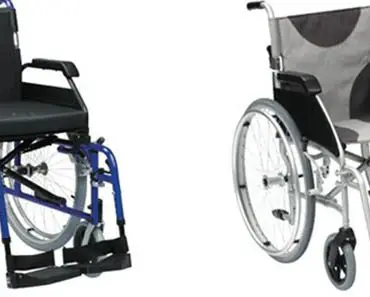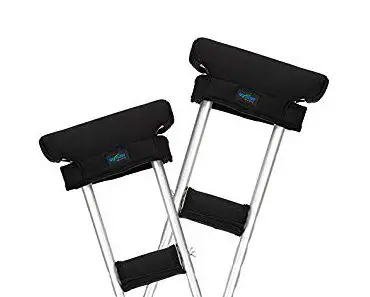There are several recovery plans that include using a walking aid after hip replacement intervention. You might be prescribed to have a cane or buying crutches.
When it comes to crutches, some doctors advise patients to use the whole pair, while there are cases, though, it’s better to go with one crutch only.

Hip replacement surgery overview that predetermines using one crutch

A common intervention
A hip replacement is might sound as quite serious surgery, but the truth is that it’s a common one and usually there are no complications you should worry about. The intervention includes your eroded or otherwise damaged hip joint replacement with a synthetic ball and socket.
Reasons
The surgery might be a must due to the last stage of arthritis, but it is not the only reason surgeons recommend such an intervention. Incidents or sports traumas might be also reasons to put you in a situation to have your hip replaced.

Recovery plan
In all cases, though, during the first days walking after might be painful and difficult. That’s why a good recovery plan is a must. Such rehabilitation usually includes crutches to be involved and today we’ll talk about using one crutch.

Things to know in advance for using one crutch after hip replacement
Using one crutch is not hard after such an intervention and a few lines below we will give you all the tips you need to know in advance. However, before the walking process, it is essential to know some basic tips to follow during your overall rehabilitation.
Be active!

- On mandatory follow your therapist’s exercise routine. Being active during recovery is a must. However, meanwhile, it is not ok to put too much pressure on you, but increase the speed of walking and exercise hardness level gradually.
Lose weight!

- Pay some serious attention at your weight. It is not ok to put too much weight on you, because whether with a crutch or with a cane, the more you weigh, the harder it gets to walk around. Plus, you will get quite many side effects like skin irritation and body pains.
Prepare your house!
- Prepare your house for the recovery process. Of course, you can do that before the surgery and it’s the best alternative as you will be able to arrange the interior the way it will be convenient especially for you. If you are late, don’t hesitate to ask for help.
The full guide for using one crutch after hip replacement
Feel free now to check out our detailed guide regarding how to recover after hip replacement intervention with a single crutch now.
Basic tips on how to use one crutch after hip replacement:
Let’s start with some general pieces of advice to keep in mind when using a crutch after hip replacement. These tips are basic, which means they are suitable to know regardless of the individual medical case of yours.
The first days are crucial
- Don’t get on the crutch only a few hours after the surgery. The first days are crucial and it’s better to remain in the bed. Wait for your therapist to give you a sign.
Guided by a professional
- Your first attempt to walk with one crutch should be guided by a professional and it’s better to perform this challenge under the observation of a professional therapist.
Don’t give up
- Don’t give up if you feel some difficulties in your first attempts. It’s hard and it’s painful, we do understand that. It’s better to make small steps at first and eventually to get used to the walking aid.
Choose a good model of crutch

- Choose a good model of crutch especially for cases like yours, an intervention for hip replacement. The good news is that the market is full of various crutch models and there are plenty of them designed for medical cases like yours.
If you are not satisfied with the model you have bought for your hip replacement recovery, it’s better to replace it with a new one rather than suffering and experiencing discomfort and pain.
Walking around with one crutch after hip replacement
You can start with these tips once you feel confident enough to get out of the bed and make your first steps. In all cases, don’t rush.
If you feel a high level of pain or discomfort you can always postpone the first walk on one crutch for later. During this period you are always free to use some assistant near you.
Steps:

- Put the injured leg forward with the crutch held on the uninjured side (opposite)
- Bear weight on the injured leg and assisted with the crutch as needed.
- Step through with the uninjured leg.
- How to take the stairs with one crutch after hip replacement

Stairs have always represented the worst obstacle to pass by after a surgery or any intervention of a leg. When you have any reduced movability, the staircase looks like a total nightmare. But don’t get it wrong. It’s a totally surmountable obstacle and with the following tips, you can cope with the problem.
Basic tips:
- If there are no stair rails, you should better to ask for help or get the elevator. Though, if there is no possibility for that, don’t panic. As a matter of fact, taking the stairs is easier with one rather than with two crutches.
- When you go up the stairs, hold onto the rail with one hand and the crutch with the other hand (or both crutches if no rail).
- When you, then, go down the stairs, place the injured leg and the crutches down on the step below; support weight by leaning on the crutch. Then, move the uninjured leg down. Now, with your weight supported by the crutches and injured leg, step down with the uninjured leg.
Additional tips on walking with one crutch after hip replacement
-
Avoid uneven surfaces

It is recommended to always avoid uneven surfaces, especially during your first day of the rehabilitation. In such a situation you can either walk around the uneven surface or ask for some assistance anybody near you.
-
Different periods of time for recovery
Don’t rush on leaving the crutch. Different patients need different periods of time for recovery. The thing is that factors like level of injury, age, and previous active life or lack of it predetermine how fast you will go through the entire rehabilitation. In all cases, listening to your therapist how to progress is the best thing you can do.

-
No storage problem
Using one crutch is better than one mainly for a single specific reason – you don’t have to carry so many walking aids. That’s why if you get used to the crutch fast you can literally continue your everyday life, including to travel as the storage problem will not be actually any problem.
-
Consider the alternatives
Some people find lots of difficulties, though, into getting used to the crutch. It’s a must to wait for a couple of days to see if you are progressing at all. If the discomfort continues and you find out you cannot use the crutch, talk to your therapist and consider alternatives like using a cane or taking a wheelchair.
Conclusion
Now, when you know how important is to be careful when using one crutch after hip replacement, as well as what the most appropriate occasions for performing such a movement are, you can make some tests on a flat surface at first and then, to try the procedure on the stairs.
Please, let us remind you that these are not recommendations from a real doctor and the material has an only informative character. Always ask your therapist if a certain using crutches or one crutch only is appropriate for your individual medical case.
If you have some questions to ask or information to receive whether specifically for the hip replacement intervention or for the recovery with one crutch later, do not hesitate to contact us. We are always here to support and give you as many tips for fast and painless rehabilitation as possible.
Good luck!






